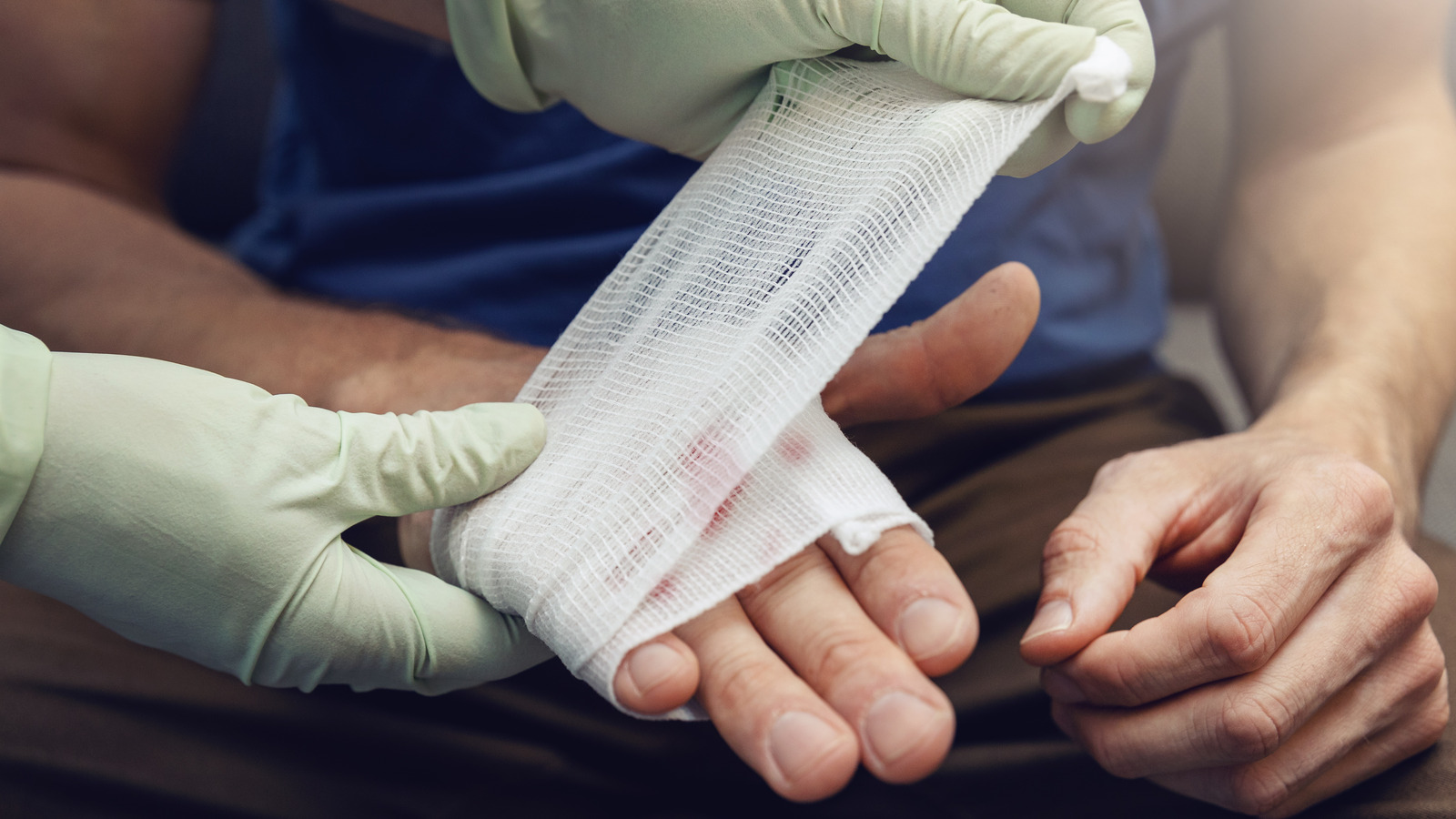
How Long It Really Takes To Bleed To Death – Health Digest
Death is not an easy subject to discuss. It leaves us with a series of questions, many of which may be existential or practical. How will it happen? Will it hurt? How long will it take? The exact amount of time it takes for a person to pass away will depend on the cause of death. For example, a person who experiences sudden cardiac arrest (SCA) may die within minutes without medical intervention (via MedlinePlus), while the dying process may last for months or even years for a person who is terminally ill. In cases of trauma or injury, how much time does it physically take for a person to bleed to death?
Our body houses a large amount of blood. In fact, the American Red Cross reports that an adult weighing between 150 and 180 pounds (lbs) has anywhere between 1.2 and 1.5 gallons of blood circulating through their body. That’s the equivalent of approximately 24 cups of blood (via AskNumbers). Injury from a motorcycle crash, workplace accident, blunt force, or stab or gunshot wounds are a few examples of incidents that may put one at risk for bleeding to death, or hemorrhaging, reports Healthline. Let’s take a closer look at what happens when a person experiences significant blood loss.
External versus internal bleeding
 sfam_photo/Shutterstock
sfam_photo/Shutterstock
As a person progressively loses more blood, hemorrhagic shock will start to set in without treatment. Early symptoms may include sweating, dizziness, nausea, fatigue, or headache. Blood loss is considered severe once a person loses 40% of their blood supply (via Healthline). At this point, symptoms will worsen to include a weakened pulse, shallow breathing, pale skin that is cold to the touch, confusion, loss of consciousness, and more.
Without intervention, a person can pass away within five minutes from significant external bleeding. According to experts at PerSys Medical, this window can drop to three minutes if a person is bleeding out from an artery. But external blood loss isn’t the only way a person can bleed to death. A person can also experience internal bleeding due to an organ injury, blood vessel rupture, or aneurysm. Abdominal swelling, chest pain, stools that are black in color or of a tar-like consistency, or blood in one’s urine, stool, or vomit can all be signs of internal bleeding. Depending on how fast or slowly one is losing blood, a person may be alive for several days before bleeding to death.
How to intervene if someone is experiencing life-threatening blood loss
 Iam_Anuphone/Shutterstock
Iam_Anuphone/Shutterstock
Knowing what to do in an emergency situation can mean the difference between life and death when it comes to blood loss. “Uncontrolled bleeding is the number one cause of preventable death from trauma,” as written in the American College of Surgeons’ 2017 information booklet titled, “Stop the Bleed.”
To effectively intervene, experts advise bystanders to remember their ABCs. “A” stands for alerting emergency services. Next, if both you and the surrounding environment are safe, approach the individual and implement “B,” which means to find the bleeding injury. To do so, you’ll need to know what to look for. Life-threatening bleeding includes blood that is spurting, pooling on the ground, or continuously flowing out of the wound. Blood-soaked bandages or clothing, total or partial loss of a limb, or signs of disorientation or loss of consciousness in a person who is bleeding are also indicative of life-threatening blood loss.
Finally, “C” stands for compressing the wound. If a trauma first-aid kit is not available, place a clean cloth over the injury and apply strong pressure by pushing down hard with both hands to help stop the bleeding. If the wound is deep or the person is bleeding from the neck, shoulders, or groin, first pack the cloth or gauze into the wound before applying pressure. Maintain the pressure until medical personnel arrive.






/https%3A%2F%2Ftf-cmsv2-smithsonianmag-media.s3.amazonaws.com%2Ffiler_public%2Fea%2F27%2Fea2773f4-7b02-48f5-af92-052f8753d2ba%2Fgettyimages-532640376.jpg?resize=150%2C150&ssl=1)

/https%3A%2F%2Ftf-cmsv2-smithsonianmag-media.s3.amazonaws.com%2Ffiler_public%2F5f%2F1b%2F5f1b9f6e-6072-4667-8ad2-7bbe95ee0b14%2Fgettyimages-1314827451.jpg?resize=150%2C150&ssl=1)
/https%3A%2F%2Ftf-cmsv2-smithsonianmag-media.s3.amazonaws.com%2Ffiler_public%2Fb7%2F81%2Fb781df5a-4717-4259-8050-c23a2e393a97%2Fgettyimages-121989311.jpg?resize=150%2C150&ssl=1)
/https%3A%2F%2Ftf-cmsv2-smithsonianmag-media.s3.amazonaws.com%2Ffiler_public%2Fce%2F38%2Fce38f5cd-f222-48c9-b6f4-97bd83fb11b1%2Fgettyimages-1409429884.jpg?fit=1024%2C1024&ssl=1)
/https%3A%2F%2Ftf-cmsv2-smithsonianmag-media.s3.amazonaws.com%2Ffiler_public%2Fb3%2Fcb%2Fb3cb17ba-53f2-4126-a579-2df6b7cef998%2Fgettyimages-869979928.jpg?fit=1024%2C1024&ssl=1)






/https%3A%2F%2Ftf-cmsv2-smithsonianmag-media.s3.amazonaws.com%2Ffiler_public%2F29%2Fb1%2F29b1626f-700e-4c70-8191-1f1de83baf08%2Fmain_ci_lauren-oster_flacomemorial1.jpg?fit=1024%2C1024&ssl=1)










/https%3A%2F%2Ftf-cmsv2-smithsonianmag-media.s3.amazonaws.com%2Ffiler_public%2F3a%2F83%2F3a836d81-d58b-46a1-841b-e2f51e63756c%2Fgettyimages-2149529008.jpg?w=768&ssl=1)
/https%3A%2F%2Ftf-cmsv2-smithsonianmag-media.s3.amazonaws.com%2Ffiler_public%2F24%2F41%2F2441bd87-845d-4a55-bfa2-f083eaa7b767%2Fgettyimages-1850211971.jpg?w=768&ssl=1)



/https%3A%2F%2Ftf-cmsv2-smithsonianmag-media.s3.amazonaws.com%2Ffiler_public%2F4b%2Fe8%2F4be81712-701c-4914-b315-4b2060d916d8%2Fksc-20221211-ph-jnv01-0007orig.jpg?w=768&ssl=1)



:max_bytes(150000):strip_icc():focal(704x299:706x301)/Ella-Reed-NBC-01-051523-f649b03172894ede80514e18bbe46427.jpg?fit=1024%2C1024&ssl=1)
:max_bytes(150000):strip_icc():focal(999x0:1001x2)/linda-fruits-real-life-love-051823-1-c3ab617a48974b0798bc30fc29eb951f.jpg?fit=1024%2C1024&ssl=1)
/https%3A%2F%2Ftf-cmsv2-smithsonianmag-media.s3.amazonaws.com%2Ffiler_public%2Fea%2F27%2Fea2773f4-7b02-48f5-af92-052f8753d2ba%2Fgettyimages-532640376.jpg?w=768&ssl=1)



/https%3A%2F%2Ftf-cmsv2-smithsonianmag-media.s3.amazonaws.com%2Ffiler_public%2F07%2F20%2F0720406e-51f0-4bee-b91a-34b050bf3886%2Fnavigation-3200x1200_web.jpg?w=768&ssl=1)
/https%3A%2F%2Ftf-cmsv2-smithsonianmag-media.s3.amazonaws.com%2Ffiler_public%2F0a%2F7e%2F0a7ee487-2b70-4637-b83a-7887d06153bd%2Fanimalshibernate-v2.jpg?fit=300%2C300&ssl=1)
/https%3A%2F%2Ftf-cmsv2-smithsonianmag-media.s3.amazonaws.com%2Ffiler_public%2F0f%2Fb5%2F0fb5025a-48e7-4627-8ee6-18e1c7dc81ca%2Fmain_moose-david-dietrich-photography-11_web.jpg?fit=300%2C300&ssl=1)
/https%3A%2F%2Ftf-cmsv2-smithsonianmag-media.s3.amazonaws.com%2Ffiler_public%2F11%2Fa8%2F11a8f779-8331-4682-8899-246f3c2815ba%2Fmain_esa_ssiow_iridescent_mercury_web.jpg?fit=300%2C300&ssl=1)










/https%3A%2F%2Ftf-cmsv2-smithsonianmag-media.s3.amazonaws.com%2Ffiler_public%2Fea%2F27%2Fea2773f4-7b02-48f5-af92-052f8753d2ba%2Fgettyimages-532640376.jpg?fit=300%2C300&ssl=1)


